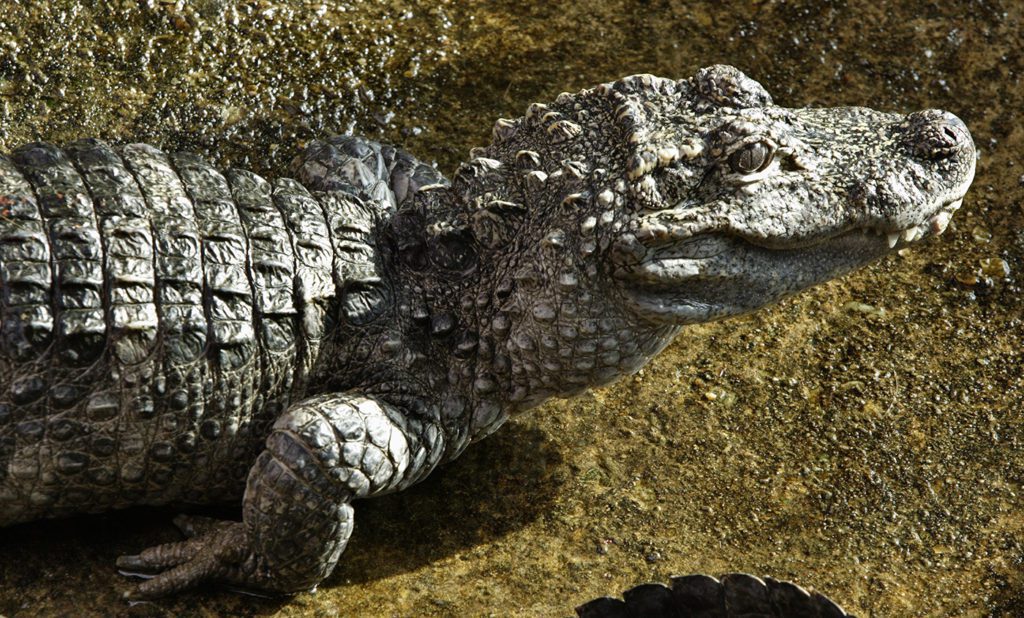Chinese alligator (Alligator sinensis)- one of the the rarest and smallest members of the alligator family. It is also called chinese swamp alligator or Yangtze Alligatorbecause it lives in the Yangtze River Valley in eastern China.
This type is considered critically threateningsince its natural environment almost completely destroyed due to agriculture and development. According to scientists, there are only a few left in the wild. 150-200 individuals.
In this article, we will look at appearance, behavior, range, breeding, threats to the existence and protection measures of the Chinese alligator.

Scientific classification
🔬 Chinese Alligator taxonomy:
✔ The Kingdom: Animals (Animalia)
✔ Type: Chordal (Chordata)
✔ Class: Reptiles (Reptilia)
✔ Row: Crocodile-like (Crocodylia)
✔ Family: To the alligator (Alligatoridae)
✔ Gender: Alligators (Alligator)
✔ View: Chinese alligator (Alligator sinensis)
📌 Interesting!
Chinese Alligator a close relative of the American alligator (Alligator mississippiensis), although much smaller in size.
Appearance and features
💠 Description of the Chinese alligator:
• Sizes: Adults usually do not exceed 1.5-2 mwhile American alligators can grow up to 4-5 m.
• Weight: On average 30-45 kg, which is much smaller than other representatives of crocodyliformes.
• Colour: Dark green or blackish with a yellowish belly.
• Chairman: Shorter and wider than the American alligator.
• Scales: It has bone plates (osteoderms) even on the abdomen, which gives it additional protection.
📌 Interesting!
Chinese Alligator – the only crocodile-like creature that can survive cold winters. It is capable of go into hibernationhiding in holes.
Range and habitat
🌍 Where does the Chinese alligator live?
* Found only in Eastern China, in the Yangtze River Valley.
* Prefers swamps, lakes, rivers, and slow-flowing ponds.
* Due to habitat destruction there are only a few isolated populations left in Anhui, Zhejiang and Jiangsu provinces.
📌 Interesting!
Previously, the Chinese alligator had a much wider range, but due to the intensive use of land for rice fields its numbers have declined dramatically.

Lifestyle and behavior
🔹 Activity and territoriality
* Leads mostly nocturnal lifestyle, often basks in the sun during the day.
• Less aggressivethan the crested or swamp crocodile.
* Live in the burrowswhich it digs up in riverbanks or swamps.
🔹 Hunting and nutrition
• Basic diet:
✅ Fish
✅ Shellfish
✅ Crayfish
✅ Small mammals
✅ Birds
* Uses ambush tacticsby attacking prey from the water.
* Unlike other crocodiles, it hunts more invertebrates, because it lives in areas with fewer large animals.
📌 Interesting!
Chinese alligator has a weaker bitethan other members of the family, which is why it often eats soft prey, such as clams.

Reproduction and development
💡 How does the Chinese alligator breed?
* Mating season continues in summer (June to August).
* The female builds nest of vegetation and puts it off 10-40 eggs.
• Incubation lasts 60-70 days, in this case, the temperature determines the sex of the cubs.
* Babies hatch in September and October and remain under the mother's protection for several months.
📌 Interesting!
Mothers of Chinese alligators very caring people "they are actively protect their nest from predators and they even help the cubs hatch by breaking the eggshells.
Threats to the species and their protected status
⚠ What threatens the Chinese alligator?
• Destruction of the natural environment because of the plowing of land.
• Water pollution chemicals from the fields.
• Poaching "although hunting alligators is illegal, they are caught for illegal keeping in private collections.
🛡 Security status:
, Listed in IUCN Red List as Critically Endangered (CR).
✅ Protected by Chinese law.
✅ There are captive breeding programsIn particular, the Chinese Alligator National Nature Reserve in Anhui.
📌 Interesting!
Chinese alligator population in captivity significantly exceeds the number of individuals in the wild – over 10,000 alligators live in nature reserves and zoos.
Conclusion
Chinese Alligator – a unique representative of the alligator familywhich has survived harsh conditions and adapted to cold winters.
💡 Basic facts about the Chinese Alligator:
✔ One of the the smallest crocodile-like creatures in the world
✔ The only crocodile that goes into hibernation
✔ Critically endangered species
✔ Bred in captivity, but almost extinct in nature
Thanks to Chinese alligator breeding programs has a chance to recover, but without restoration of the natural environment, this species may disappear in the wild..